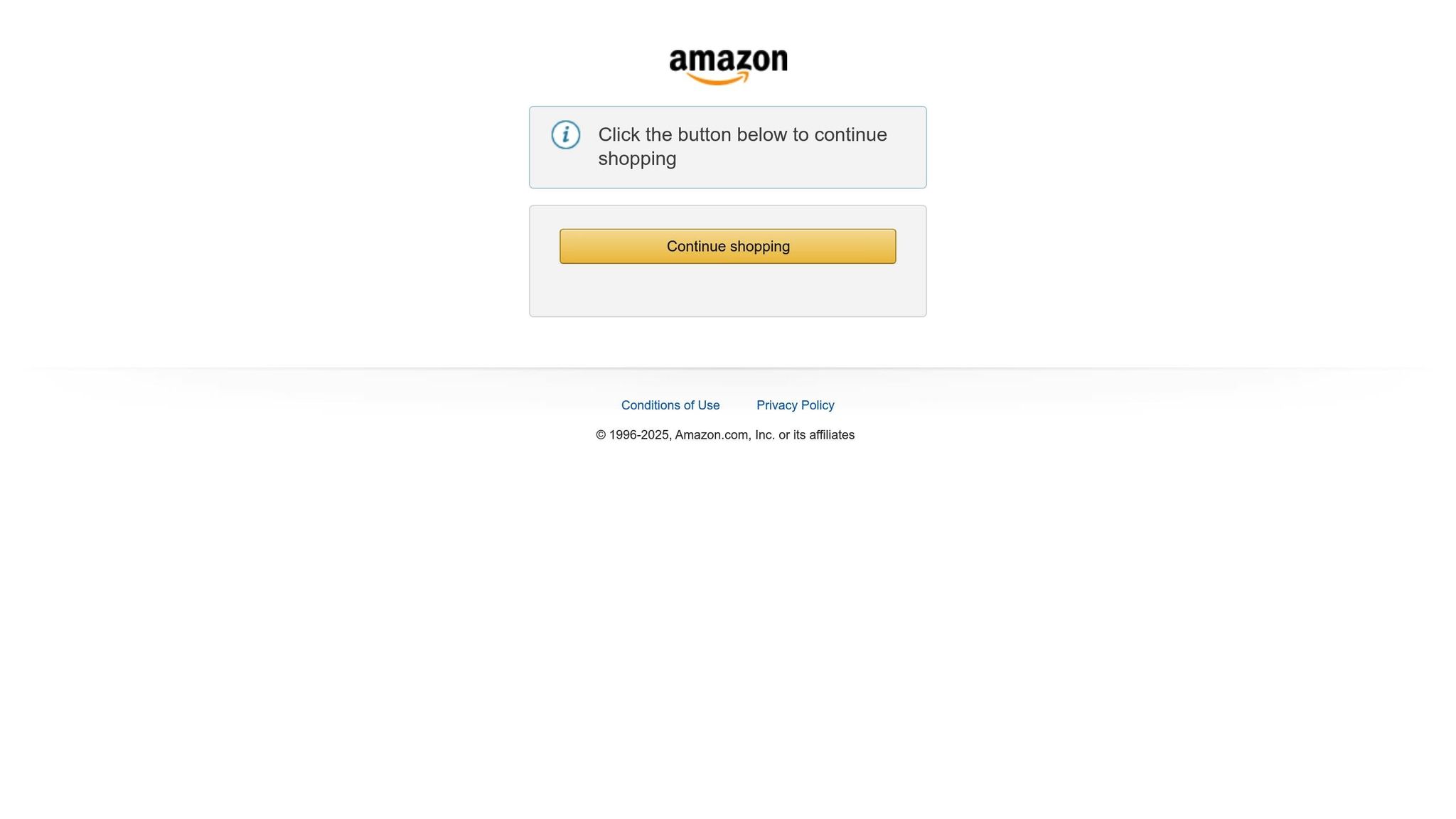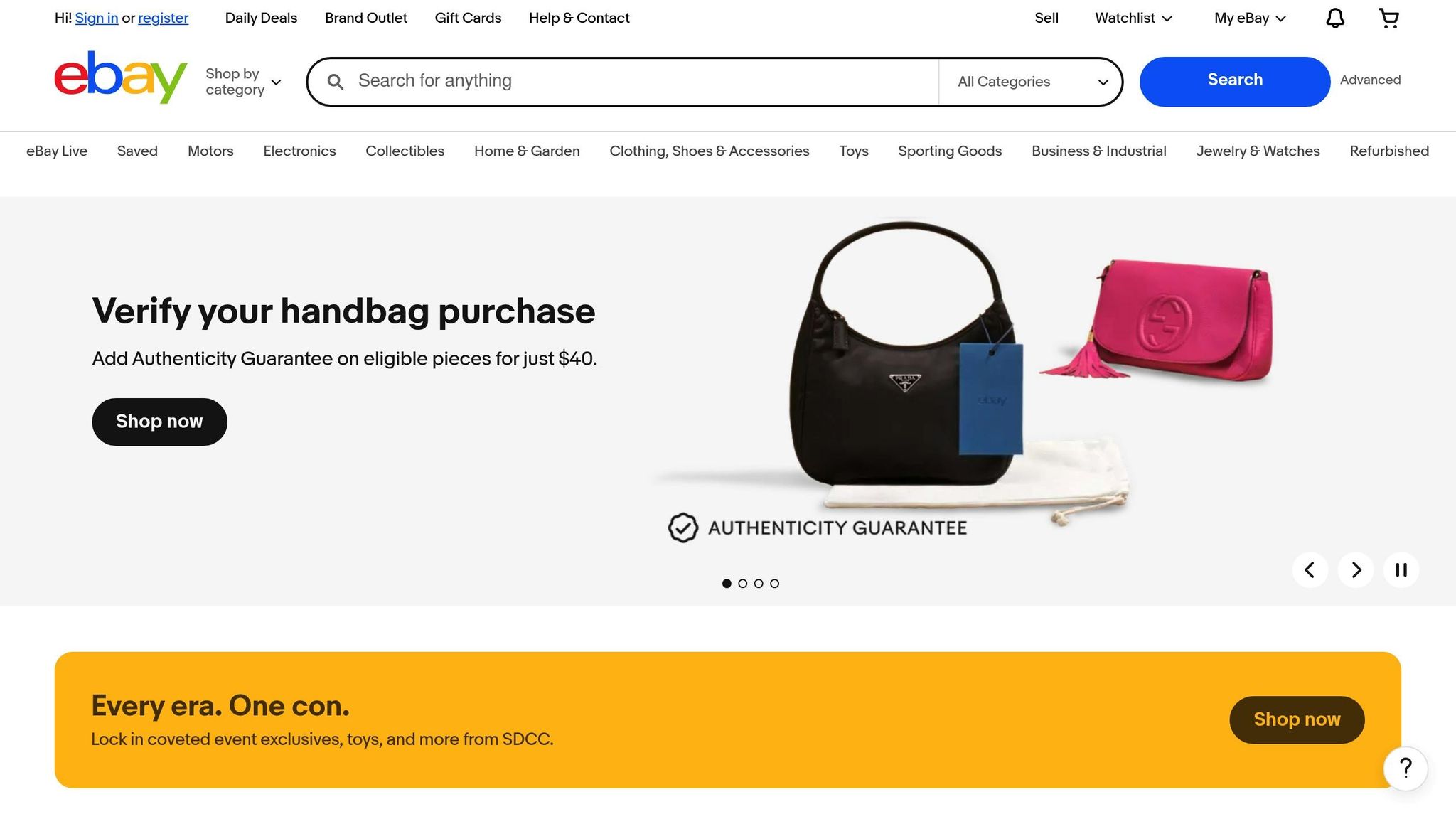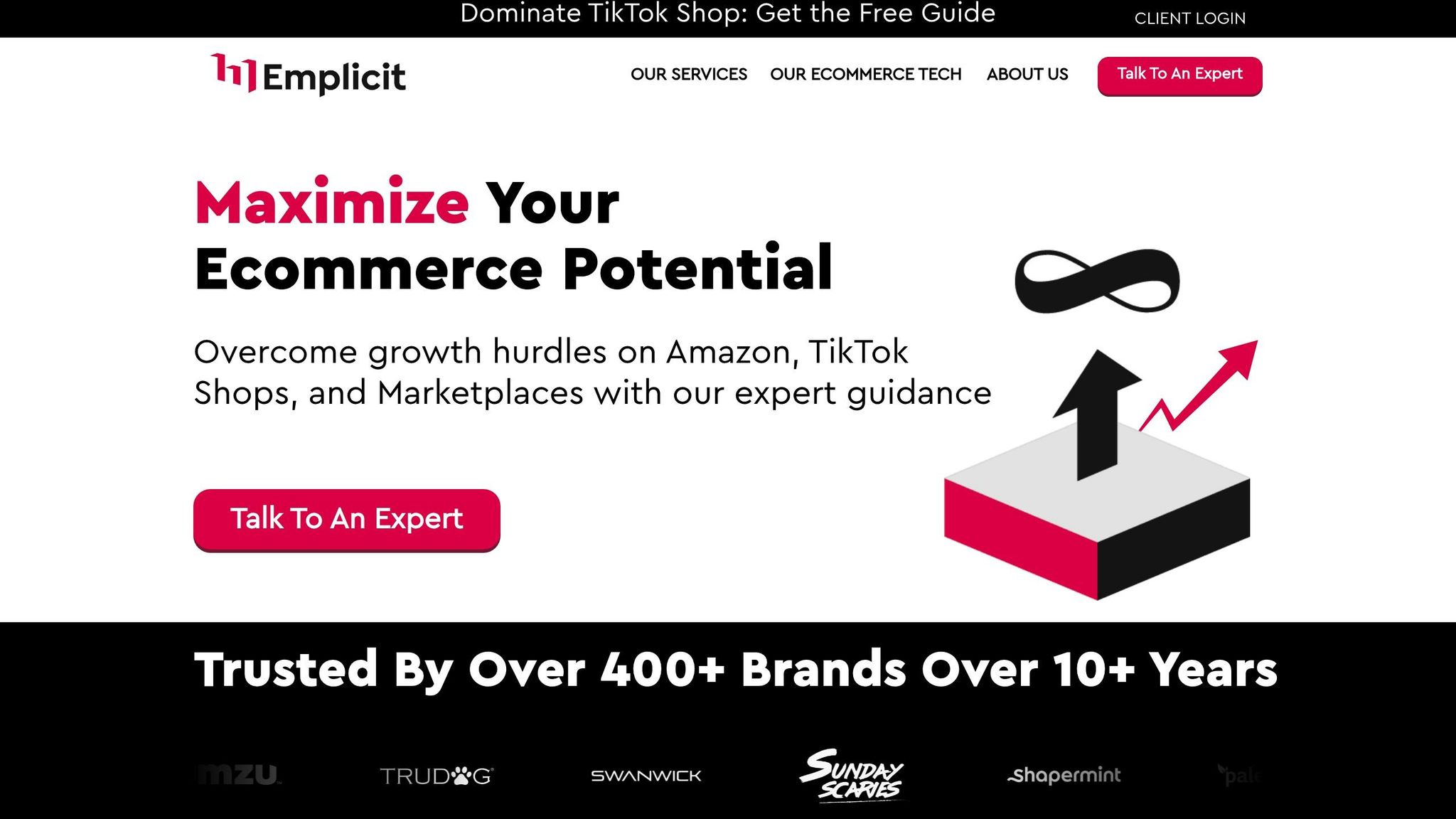
In the U.S. ecommerce market, Amazon dominates with a 37.6% market share, but competitors like Walmart, eBay, Target, and Shopify are carving out their space using distinct strategies. Each platform offers sellers unique tools and opportunities to grow. Here’s a quick breakdown:
- Amazon: Leverages Fulfillment by Amazon (FBA) for logistics, global reach, and Prime shipping perks. Independent sellers account for over 60% of its sales, with tools like PPC campaigns and automation software driving growth.
- Walmart: Combines its physical store network with an expanding online presence, offering competitive pricing and fulfillment options like in-store pickups.
- eBay: Focuses on flexible selling formats (auctions, fixed-price) and international reach through its Global Shipping Program.
- Target Plus: Invite-only marketplace emphasizing premium brands and curated product offerings.
- TikTok Shop: Targets younger audiences with content-driven selling strategies.
Key Insights:
- Multi-platform selling increases revenue by 190% on average.
- Amazon sellers using FBA see cost savings of up to 70% on shipping.
- Walmart’s ecommerce growth (13.6%) is outpacing Amazon’s (10.5%).
- Diversification is essential for long-term success as shoppers increasingly use multiple channels before purchasing.
Quick Comparison:
| Platform | Key Strength | Seller Benefits | Buyer Perks |
|---|---|---|---|
| Amazon | Global reach, robust tools | FBA, PPC, automation tools | Prime shipping, vast selection |
| Walmart | Physical + online network | Lower competition, Walmart Fulfillment Services | In-store pickup, convenience |
| eBay | Flexible selling formats | Auctions, Global Shipping Program | Unique products, global access |
| Target Plus | Curated marketplace | Premium brand positioning | High-quality product selection |
| TikTok Shop | Content-driven sales | Younger audience, video-based engagement | Interactive shopping experience |
For sellers, focusing on one platform simplifies operations, while multi-platform strategies broaden reach and reduce risks. Ultimately, understanding each platform’s strengths helps businesses scale effectively.
Amazon vs. Ecommerce Giants: Who’s Winning the Online Retail Battle?

Amazon Seller Growth Tactics
Amazon’s rise to dominance is fueled by its robust tools designed to help sellers scale quickly. One standout feature is Fulfillment by Amazon (FBA), which takes care of logistics like storage, picking, packing, shipping, customer service, and even returns. This allows sellers to concentrate on growing their businesses. FBA also gives products an edge by qualifying them for free two-day Prime shipping, a perk that builds trust with customers and boosts conversion rates. On top of that, Amazon’s extensive global fulfillment network helps sellers reach customers worldwide, all while saving on costs – shipping through FBA can be up to 70% cheaper per unit compared to premium options from major U.S. carriers. New sellers also enjoy perks like shipping credits, free storage, and fulfillment cost credits. Tools such as the Amazon Revenue Calculator and Inventory Performance Dashboard further help sellers streamline operations and maximize efficiency.
"As long as I have my tools and materials, I can depend on FBA to keep my income constant." – Marcia Asuncion Ricchiuti, Founder, Kahili Creations
PPC and Listing Optimization
Combining targeted pay-per-click (PPC) campaigns with well-optimized product listings can significantly improve conversion rates. Optimizing a listing involves thorough keyword research, creating compelling titles, and crafting detailed bullet points that highlight product features and benefits. Advanced sellers often take it a step further by using automated tools for bid management and keyword optimization, ensuring their advertising campaigns deliver the best possible return on investment. Beyond PPC, automation tools can integrate seamlessly into daily operations, helping sellers maintain steady growth.
Automation Tools for Operations
Automation plays a crucial role in simplifying and scaling Amazon businesses. Sellers often turn to third-party SaaS platforms for tasks like product research, listing optimization, analytics, and ad management. For instance, Helium 10 offers a comprehensive suite of tools, with subscription plans ranging from approximately $29 to $279 per month.
PPC automation tools like AiHello, Perpetua, and Zon Tools provide services starting at $9 per month, with premium plans going up to $695 per month. These tools help sellers fine-tune their advertising strategies with minimal manual intervention.
Equally important is inventory management automation. These systems track stock levels, send automated reorder alerts, and integrate directly with Amazon’s fulfillment centers. By reducing stockouts, avoiding overstocking, and minimizing manual errors, these tools ensure smooth operations. When sellers adopt automation across key areas like inventory, pricing, and advertising, they can scale their businesses significantly without adding unnecessary workload.
Competitor Growth Strategies
Competitors in the e-commerce space use a variety of strategies to carve out their share of the market, often offering alternatives to Amazon’s model. While Amazon’s vast ecosystem creates a tough benchmark, some rivals focus on addressing specific needs for both sellers and buyers. Take eBay, for example – it stands out with its adaptable selling formats and tools designed to boost seller credibility and expand global reach. Let’s dive into the details of eBay’s approach.
eBay: Flexible Selling and Global Access

eBay provides sellers with more than just fixed-price listings. Its auction-style sales and Best Offer options allow sellers to set dynamic pricing, making it ideal for unique or hard-to-price items.
To build trust, eBay relies on its feedback and ratings system, encouraging sellers to maintain strong performance. Sellers who keep defect rates low and ship quickly benefit from better search rankings and reduced fees.
On the global front, eBay’s Global Shipping Program simplifies international sales. U.S. sellers can tap into worldwide demand without worrying about customs or logistics – eBay handles that for them. Additionally, tools like Seller Hub Promotions and features such as Promoted Listings give sellers the ability to run targeted discounts and boost product visibility, helping them stand out in a crowded marketplace.
Growth Tactics Comparison
Sellers today are exploring a variety of growth strategies tailored to different platforms to achieve better results. Each platform comes with its own set of tools and advantages, making it crucial for sellers to understand these differences. This knowledge helps them align their approach with specific business goals and their unique operational needs.
Platform Tools and Strategies Comparison
Amazon stands out with its all-in-one ecosystem that combines robust fulfillment services and powerful marketing tools. Meanwhile, platforms like Walmart and eBay take a different approach. Walmart leans on its extensive physical retail presence, offering competitive pricing and convenient fulfillment options. On the other hand, eBay provides a more flexible selling environment, ideal for niche markets and unique product offerings. This comparison underscores Amazon’s broad, integrated capabilities versus the more specialized strengths of its competitors.
With these differences in mind, sellers must decide whether to focus their efforts on a single platform or spread them across multiple channels.
Multi-Platform vs. Single-Platform Tactics
When it comes to leveraging platform-specific strengths, sellers face a key decision: Should they focus on mastering one platform or diversify across several? A single-platform strategy simplifies operations, streamlines inventory management, and allows sellers to deeply understand one platform’s tools and policies. However, multi-platform selling offers a broader reach. In fact, 42% of businesses now use this approach, and those employing cross-platform strategies report revenue increases averaging 190%. Additionally, 73% of shoppers interact with multiple channels before completing a purchase.
Multi-platform strategies can also cut total expenses by 40–50%. Gartner forecasts that by the end of 2025, over 60% of enterprise mobile apps will be developed using cross-platform technologies, reflecting a growing trend among larger businesses to manage multi-channel complexity effectively.
The right choice often depends on the size and resources of the seller. For small businesses, focusing on one platform allows them to build expertise and streamline operations. Larger enterprises, however, tend to benefit from multi-platform strategies, which provide wider reach and cost efficiencies. Mid-sized businesses frequently start with a single platform to gain experience and capital, then strategically expand to additional marketplaces that cater to diverse customer bases.
These strategic decisions pave the way for success, as illustrated in the upcoming case studies.
"Platform companies have become increasingly important to the global economy and are some of the largest and most valued companies today." – Harvard Business School Professor Feng Zhu
sbb-itb-e2944f4
Case Studies: Growth Tactics in Action
Let’s dive into some real-world examples showcasing how specific strategies can lead to measurable success.
Amazon Seller Success Examples
Optimizing Product Titles for Better Traffic
Amazon sellers who crafted detailed product titles saw a significant boost in organic traffic. In fact, 90% of top-selling pages had titles exceeding 50 characters. For instance, an electronics seller reported a noticeable increase in organic traffic after fine-tuning their product titles while adhering to Amazon’s 200-character limit.
Monthly Listing Updates That Deliver Results
A home goods brand adopted a monthly refresh strategy for their listings, updating titles, bullet points, descriptions, and keywords. This consistent effort improved both organic visibility and conversion rates. They also enhanced performance further by conducting A/B testing on main images using Amazon’s built-in testing tools.
Leveraging Video Content
A fitness equipment seller made full use of Amazon’s video features. They created videos highlighting product features, usage tips, and brand identity while encouraging customers to share user-generated content. This approach not only improved product visibility but also drove higher conversion rates.
Smart PPC Campaign Management
A kitchen appliance seller achieved better Advertising Cost of Sales (ACoS) by manually managing their PPC campaigns. With expert oversight, they used real-time bid adjustments and regular audits to fine-tune their strategy.
Amazon FBA expert Tomer David emphasizes the importance of adaptability:
"Whenever Amazon introduces a change, it’s an opportunity for sellers who adapt quickly to gain a competitive edge".
Driving External Traffic
A beauty brand tapped into social media and influencer partnerships to funnel external traffic to its Amazon listings. Combined with a targeted email marketing campaign, this strategy significantly boosted sales growth.
Competitor Platform Success Examples
Now, let’s look at how sellers on other platforms have used unique strategies to capture market share.
Walmart Marketplace: Standing Out with Less Competition
A toy manufacturer took advantage of Walmart Marketplace’s smaller seller base – just 150,000 sellers compared to Amazon’s 2.3 million. By focusing exclusively on Walmart and utilizing Walmart Fulfillment Services (WFS), they enjoyed faster shipping times and lower fees, which led to rapid growth and a strong competitive edge.
eBay: Tapping Into Global Markets
A vintage clothing seller leveraged eBay’s international buyer base and auction-style format to expand globally. By optimizing listings with international search terms and using eBay’s translation tools, they significantly increased international sales while testing pricing strategies tailored to diverse markets.
Target Plus: Elevating Brand Value
A sustainable home goods brand gained entry into Target Plus, an invite-only marketplace for high-quality brands. By highlighting their sustainability efforts and premium positioning, they achieved higher average order values and maintained strong profit margins through Target’s curated approach.
TikTok Shop: Reaching Younger Audiences
A fashion accessories brand identified TikTok Shop as a way to connect with younger shoppers. By launching with a content-first strategy featuring engaging short-form videos, they attracted a younger demographic and diversified their revenue streams.
These examples underline the importance of tailoring strategies to match the unique strengths of each platform to achieve scalable growth.
How Full-Service Ecommerce Support Helps
Expanding across multiple online platforms can be a tough challenge. Sellers often face hurdles with PPC campaigns, inventory management, and ever-changing platform algorithms.
Full-service ecommerce providers step in with tailored solutions, combining specialized knowledge and cutting-edge tools to deliver the best outcomes. These agencies cover every aspect of online selling – from marketing strategies to inventory oversight – using data-driven methods to improve customer experiences and increase conversions. Instead of relying on trial and error, they leverage advanced technologies that might be out of reach for smaller businesses. Plus, their industry expertise keeps sellers ahead of the curve as new trends emerge.
Having a single point of contact simplifies operations and saves valuable time. This streamlined approach is especially helpful when scaling up, entering new markets, or keeping stores secure and up-to-date. By offering comprehensive support, these providers enable businesses to implement focused strategies that drive measurable growth.
Emplicit‘s Role in Scaling Ecommerce Businesses

Emplicit takes these benefits a step further, delivering growth across platforms like Amazon, TikTok Shops, Walmart, and Target. With over $550 million in sales managed and more than $100 million in ad spend, their results speak volumes. For instance, AllGood saw monthly revenue jump from $35,000 to $165,000 in just three months – a fivefold increase. Trtl Travel achieved 400% growth in a year, while Just Thrive has maintained steady 20% year-over-year growth for more than four years. Emplicit’s success comes from crafting customized solutions tailored to each business, managing over 40,000 unique products, and offering services like PPC management, listing optimization, inventory control, and account health management.
What sets full-service providers like Emplicit apart is their ability to identify pain points, create detailed strategies, and execute marketing plans that help businesses grow. They assist with expanding product lines, entering new markets, and reaching additional marketplaces. This approach is crucial in an environment where Amazon alone accounts for nearly 40% of the U.S. ecommerce market. These providers handle everything from logistics to analytics more efficiently than in-house teams can. Their support isn’t limited to Amazon, either – they cover off-platform marketing through Google Search, Google Shopping, Facebook, and other social media platforms. By partnering with these experts, businesses save time and resources while ensuring every aspect of their online sales is managed professionally.
Conclusion
Amazon and its competitors employ different strategies to fuel their growth, offering valuable insights for U.S. sellers. Amazon’s dominance is powered by its tech-driven ecosystem, boasting over 310 million customers and 200 million Prime members. On the other hand, Walmart takes advantage of its omnichannel approach, reaching 90% of the U.S. population within a single day by utilizing its extensive network of stores as fulfillment centers.
The numbers make one thing clear: a diversified approach is key to sustained growth. While Amazon holds the lead, Walmart is currently outpacing it in ecommerce growth – 13.6% compared to Amazon’s 10.5%. This highlights the importance of not relying solely on one platform. Each marketplace has its strengths: Amazon shines in global reach and advanced personalization, while Walmart’s hybrid model combines online convenience with physical store accessibility.
Long-term success hinges on balancing focus with flexibility. For instance, independent sellers on Amazon averaged over $290,000 in annual sales, with more than 55,000 sellers exceeding $1 million during the same period. However, savvy sellers are branching out to platforms like Walmart, Target, and TikTok Shops, reducing their dependence on a single channel and reaching a broader range of customers. By mastering the nuances of each platform and building a multi-channel strategy, sellers can maximize their growth potential.
Small businesses can thrive by honing in on niche products, delivering outstanding customer experiences, and truly understanding their audience. This includes crafting optimized listings, offering competitive pricing, and running well-planned PPC campaigns on platforms like Amazon. At the same time, expanding into additional channels like Walmart and TikTok Shops helps mitigate risks and tap into new customer bases. The key is to adapt quickly to each platform’s unique environment while maintaining consistent brand quality.
FAQs
How does Fulfillment by Amazon (FBA) help sellers stand out in the ecommerce market?
Amazon’s Fulfillment by Amazon (FBA) program gives sellers a competitive edge by simplifying logistics and enhancing the shopping experience for customers. With FBA, sellers can provide fast and dependable shipping options – like Prime delivery – that make their products more attractive to buyers.
On top of that, FBA takes care of customer service and returns, allowing sellers to concentrate on expanding their business. By tapping into Amazon’s extensive fulfillment network, sellers can grow their operations while keeping up with customer demands for quick and convenient service.
What are the pros and cons of using a multi-platform strategy for ecommerce businesses?
Expanding to multiple platforms can be a game-changer for ecommerce businesses. It helps you connect with a broader audience, drive more sales, and enhance your brand’s presence. Plus, by spreading your efforts across different platforms, you’re not putting all your eggs in one basket, which reduces the risks of relying on just one channel. Another bonus? You can strengthen customer loyalty by being available wherever your shoppers prefer to make their purchases.
But let’s not ignore the hurdles. Managing several platforms means juggling tasks like keeping inventory updated across the board, ensuring your branding stays consistent, and navigating the added complexity of logistics – think order fulfillment and shipping. On top of that, each platform demands attention and resources to keep things running smoothly and to provide a hassle-free experience for your customers. It’s a balancing act that requires careful planning and execution.
How do Walmart and eBay stand out from Amazon in terms of benefits for sellers and buyers?
Walmart stands out to sellers by offering lower fees and facing less competition, making it an attractive choice for those wanting to establish themselves without battling too many rivals. For shoppers, Walmart focuses on affordable prices and a smooth shopping experience, drawing in budget-conscious customers.
eBay caters to sellers who value autonomy and flexibility, giving them more control over pricing and how they present their listings. For buyers, eBay shines with its unique, personalized offerings and the chance to discover rare or hard-to-find items.
Amazon dominates with its unmatched scale and fulfillment services, giving sellers access to an enormous audience and providing buyers with fast and dependable delivery.
